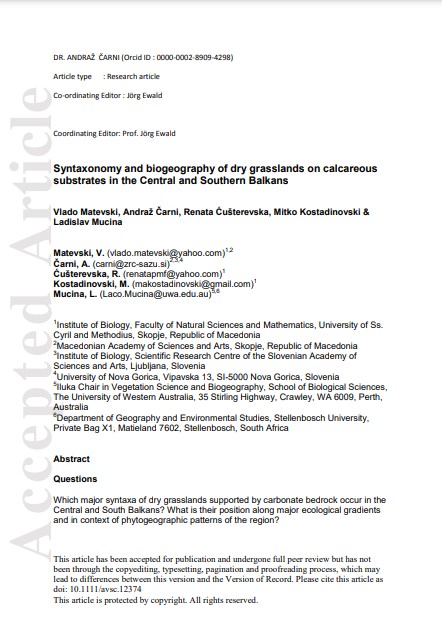Syntaxonomy and biogeography of dry grasslands on calcareous substrates in the central and southern Balkans
Bosque Modelo:
Nova Forest Alliance
Temática:
Conservación
Tipo de documento:
Artículo científico
Resumen
Questions Which major syntaxa of dry grasslands supported by carbonate bedrock occur in the Central and South Balkan s? What is their position along major ecological gradients and in context of phytogeographic patterns of the region?
Location Central and South Balkans, incl. Western Bulgaria, Northern Greece, Kosovo, Macedonia (FYROM) and Serbia
Methods We compiled a matrix of 660 relevés of dry grasslands over lime rich bedrocks, previously classified in the Festuco -Brometea. We applied clustering techniques to classify separately synoptic and relevé data, and applied non-metric multidimensional scaling with passive projection of indicator values, climatic data, and biogeographic geo-elements onto ordination diagrams to assist interpretation of the syntaxonomic patterns. We constructed elevation distribution profiles for alliances and classes of grasslands of several grassland classes from a broader study area to elucidate the relationship of the elevational sorting of the syntaxa in relation to latitude.
Results The analysis revealed six major vegetation types, classified into four orders: (1) Stipo pulcherrimae
Festucetalia pallentis, incl. (sub)montane rocky steppic grasslands of the Saturejion montanae of Central Balkans, and the Koelerio-Festucion dalmaticae submontane rocky grasslands of southern Serbia and Kosovo; (2) Astragalo onobrychidis-Potentilletalia represented by the Saturejo-Thymion (low-elevation steppic grasslands of Southern Balkans); (3) Festucetalia valesiacae represented by grasslands on deep-soil and low-elevation of Northern Greece, and finally (4) high -elevation rocky grasslands of Southern Balkans, classified as a new alliance —the Diantho haematocalycis-Festucion hirtovaginatae that might belong to a new, yet undescribed syntaxonomic order. Ordination suggest s that the major differentiation of the high -rank syntaxa follows north-south geographical and low-highelevational gradients.
Conclusions Because of the transitional biogeographic position of the studied region as well as considerable large elevation span across latitudes, the diversity of vegetation types is high. The indication a putative new dry -grassland order the mid -high altitudes of the Southern Balkans point s upon a necessity of re -assessing the Balkan vegetation occupying the community niche between the low-elevation dry grasslands (Festuco-Brometea) and those typical of high elevations (Elyno-Seslerietea and Daphno-Festucetea), seeking parallels to patterns described from the Western Alps, Pyrenees, and Apennines. This syntaxonomic unit is poised to expand the concept of the Festuco hystricis -Ononidetea striatae to the Balkans.
Información Bibliográfica
Autor:
Matevski, Vlado; Carni, Andraz; Custerevska, Renata; Kostadinovski, Mitko; Mucina, Ladislav
Revista:
APPLIED VEGETATION SCIENCE
Año:
2018
N°:
3
País :
Canadá
Páginas:
488 - 513
Volumen:
21
Idioma:
Ingles
Palabras claves
: Balkan; Biogeography; Classification of vegetation; Climate; Dry grasslands; Elevation; Festuco hystricis -Ononidetea striatae; Festuco -Brometea; Gradient; Latitude; Mediterranean





